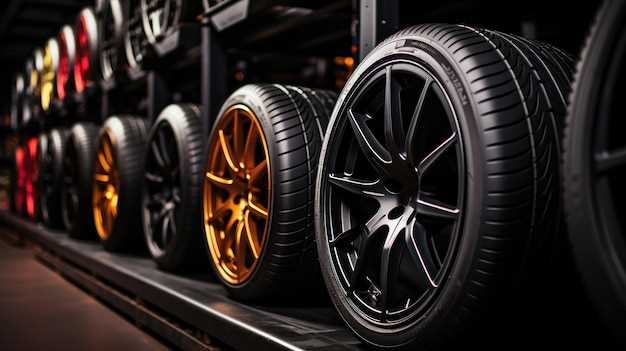
Choosing the right racing tires for your vehicle is a crucial step in maximizing performance on the track. Grip is the key factor that can significantly influence your lap times and overall race experience. High-quality tires provide the necessary traction, allowing you to accelerate faster, brake more effectively, and navigate turns with precision. Understanding the relationship between tire composition, tread design, and the specific racing conditions you will face is essential for making an informed choice.
Different racing disciplines have distinct demands, and the tires you select must align with these requirements. For instance, a tire designed for sprint races may prioritize grip on a dry surface, while endurance racing tires might focus on longevity and consistency over multiple laps. Additionally, factors such as weather conditions, track surface characteristics, and your individual driving style also play a role in tire selection. By analyzing these variables, you can pinpoint the ideal tire that meets your needs for each unique race scenario.
In this article, we will delve deeper into the various types of racing tires available, how to assess their performance metrics, and tips for how to select the best option for your vehicle. Whether you’re a seasoned racer or a novice looking to improve your skills, understanding the intricacies of tire selection is imperative for achieving success on the race track.
Assessing Grip Requirements for Different Racing Conditions

When selecting tires for racing, understanding the grip requirements for various conditions is crucial. Grip is influenced by several factors including track surface, weather conditions, and driving style. Each of these elements can significantly impact tire performance, making it essential to choose the right tires to maximize traction.
Dry Conditions: In dry weather, tires with a softer compound generally provide enhanced grip. Softer rubber allows for better contact with the track surface, resulting in improved cornering stability and acceleration. Racing slicks are often favored in these conditions due to their lack of tread, maximizing the contact patch and ensuring optimal performance.
Wet Conditions: In contrast, wet conditions demand tires with grooves to channel water away from the contact patch. This design helps prevent hydroplaning and maintains grip on slippery surfaces. Intermediate tires can bridge the gap between slicks and full wet tires, offering versatility when the weather changes unpredictably during a race.
Mixed Surfaces: Racing on tracks that feature mixed surfaces or varying grip levels requires careful consideration. Tires with adjustable tread patterns can adapt to different sections of the track, ensuring consistent performance. It’s essential to assess the balance between grip and durability, as different surfaces may wear tires unevenly.
Ultimately, selecting the right tires involves not only understanding grip requirements based on racing conditions but also considering vehicle setup, weight distribution, and driver preferences. Experimentation and data analysis can help identify the optimal tire choice, leading to better performance and enhanced safety on the track.
Understanding Tire Composition and Its Impact on Performance
Tire composition is crucial in determining the overall performance of racing vehicles. The materials used in manufacturing tires significantly affect their grip, durability, and responsiveness on the track. Most racing tires are crafted from a combination of natural and synthetic rubbers, reinforcing materials, and chemical additives. Each component plays a distinct role in enhancing performance.
The rubber compound is the primary factor influencing the grip of a tire. Softer compounds provide better traction and are ideal for dry conditions, allowing for quick acceleration and tight cornering. However, softer tires wear out more rapidly, which can be a disadvantage during long races. Conversely, harder compounds are more durable, suitable for longer stints but may lack the maximum grip desired in competitive racing.
Another essential element is the tread design. Racing tires often feature specialized tread patterns that enhance water displacement and increase contact with the road. This design ensures optimal performance in various conditions, allowing drivers to maintain control at high speeds. Additionally, the tire’s profile affects handling; a lower profile generally results in improved stability during fast maneuvers.
Moreover, tire construction plays a vital role in performance characteristics. The way layers of rubber and reinforcing materials are arranged determines the tire’s flexibility and strength. A well-constructed tire offers better feedback to the driver, enhancing control and confidence during a race. Factors such as sidewall stiffness and bead construction can influence how well the tire maintains its shape under stress, which directly affects grip and handling.
In summary, understanding tire composition is essential for selecting the right racing tires. The balance between grip, durability, and responsiveness can significantly impact race outcomes. Careful consideration of rubber compounds, tread designs, and construction methods will ensure that drivers optimize their vehicle’s performance on the track.
Evaluating Tire Size and Compatibility with Your Vehicle

Selecting the appropriate tire size for your vehicle is crucial when optimizing race performance. Each vehicle has specific dimensions that dictate the size of tires it can accommodate. To ensure compatibility, refer to the manufacturer’s specifications, which usually include details about the recommended tire sizes and their corresponding rim widths.
Understanding the relationship between tire size and vehicle dynamics is essential. Larger tires can provide better grip and traction on the track, but they may also affect acceleration and steering response. Conversely, smaller tires can enhance agility and reduce weight but may compromise stability at high speeds.
Pay attention to the aspect ratio, which indicates the height of the tire’s sidewall relative to its width. A lower aspect ratio typically leads to better handling and responsiveness, making it ideal for racing scenarios. Additionally, ensure that the overall diameter of the tire fits within the wheel wells, as oversized tires can lead to rubbing issues during turns or suspension travel.
Consulting with experts or using tire compatibility guides can also aid in selecting the right racing tires. Remember that tires also affect your vehicle’s geometry; altering the size can impact alignment and handling characteristics. To achieve optimal performance, balance your choice between tire size, type, and the specific demands of your racing environment.






